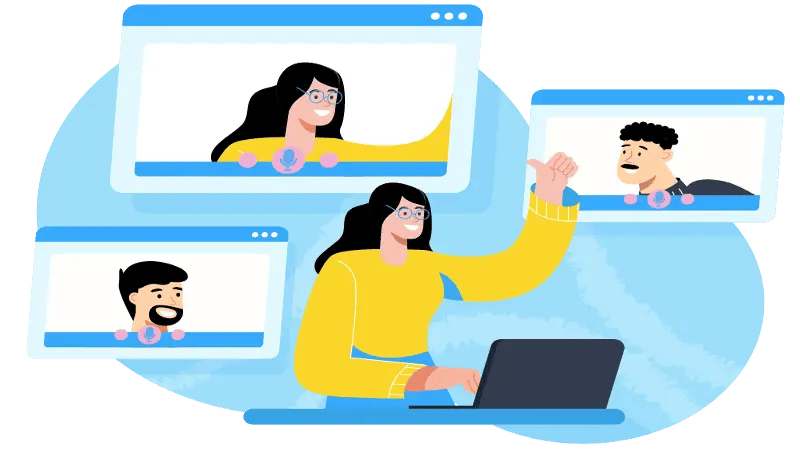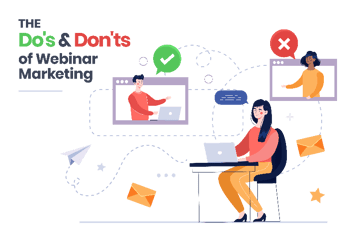Tips for Hosting a Flawless Live Webinar
If you're hosting a webinar for the first time (or even the hundredth), you may think it's the same as hosting a simple meeting. Unfortunately, it's not that simple. More finesse is required to keep your audience engaged when hosting a live webinar.
If that seems daunting, not to worry–we've got you covered. From prepping for your webinar to following up with attendees, here are the tips for hosting a flawless live webinar.

49% of B2B buyers engage with video content before they make a buying decision, and 91% of B2B professionals rank webinars as their favorite content format. So, webinars may be the best method if you're looking to convert your leads to customers.
Before the Webinar
If you want to host a flawless live webinar, adequate preparation is critical. So, prepare to embark on a journey of webinar success as we unveil the essential pre-webinar strategies. From selecting the ideal platform to crafting a captivating title and description, we'll equip you with the tools to kickstart your webinar with finesse and leave your audience eagerly awaiting the main event.
1. Select the Right Platform
Choosing the right webinar platform is crucial for delivering a seamless experience. Consider factors like ease of use, interactive features, and the platform's ability to handle your anticipated audience size. Popular webinar platforms like Zoom, Sessions, and GoToWebinar, offer reliable streaming, interactive tools, and robust features. Please take the time to evaluate different platforms and select the one that works best for your webinar's requirements.
2. Set a Date and Time
Scheduling your webinar at the right date and time is vital to maximize attendance. Consider the preferences and availability of your target audience, considering time zones and work schedules. Aim for a time slot with the highest likelihood of participation and engagement. Avoid conflicting with significant holidays or industry events that may divert your audience's attention. Consider weekdays during mid-morning or mid-afternoon as suitable options.
52% of all webinars take place on Wednesdays or Thursdays. This statistic is understandable as people are still adjusting to work on Mondays and trying to finish their work before the weekend on Fridays.
3. Craft a Compelling Title
A compelling title and webinar description are crucial for attracting attendees and generating interest in your event. Your title should be concise, attention-grabbing, and accurately reflect the content you'll be covering. Incorporate relevant keywords and phrases that align with your target audience's interests and search queries. Your webinar description should clearly summarize what participants can expect, highlighting the value they'll gain by attending. Make it engaging, concise, and persuasive, emphasizing the benefits and key takeaways.
4. Test Your Equipment
Technical glitches can disrupt your live webinar and negatively impact the participant experience. To avoid such issues, you can thoroughly test your equipment and familiarize yourself with the webinar platform's features beforehand. Ensure your internet connection is stable, your microphone and webcam are functioning correctly, and any additional tools or software you plan to use are ready.
Conduct a rehearsal where you review the entire webinar process, including slides, interactive features, and transitions. Rehearsing allows you to identify and address potential issues, refine your delivery, and build confidence in your presentation.
During the Webinar
Delivering a captivating and impactful live webinar requires effective strategies to engage your audience throughout the event. From keeping your delivery concise and energetic to sharing real-life examples that will widen their eyes with awe, we've got tips to have your audience on the edge of their virtual seats.
1. Start Strong With an Engaging Introduction
Grab your audience's attention immediately by delivering a compelling introduction. Share a captivating story, pose thought-provoking questions, or highlight the key benefits participants will gain from attending. Set the tone for the webinar, establish your expertise, and create anticipation for the valuable insights you'll be sharing.
2. Be Clear and Concise in Your Delivery
Maintain clarity and conciseness in your presentation. Use simple language, avoid jargon, and clearly articulate your ideas. Structure your content logically, and provide clear transitions between topics. Engage your audience by delivering information in bite-sized chunks, allowing easy understanding and retention.
3. Utilize Visual Aids and Demonstrations
Enhance audience understanding and engagement by incorporating visual aids and demonstrations. Use visually appealing slides, charts, and infographics to reinforce key points. Leverage videos or screen sharing to provide real-time demonstrations, making complex concepts more accessible and memorable.
4. Maintain a Dynamic and Energetic Delivery
Keep the energy levels high throughout the webinar to captivate your audience. Vary your tone, use gestures, and display enthusiasm for the subject matter. Inject humor when appropriate and share personal anecdotes to create a connection with participants. Your dynamic delivery will hold their attention and leave a lasting impression.
5. Encourage Participation
Foster an interactive environment by encouraging audience participation during the webinar. Incorporate live chat, polls, or Q&A sessions to allow attendees to engage actively. Prompt them to ask questions, share their thoughts, or respond to prompts. Address their input and queries promptly to create a sense of involvement and collaboration.
6. Share Real-Life Examples
Illustrate your points with relevant and relatable real-life examples. Share success stories, case studies, or customer testimonials to provide practical applications and build credibility. These examples are valuable proof points, reinforcing your concepts and helping participants connect the information to real-world scenarios.
7. End with a Strong CTA
Conclude your webinar with a powerful call to action. Communicate the desired action you want participants to take after the event, whether signing up for a follow-up session, downloading a resource, or purchasing. Emphasize the benefits of taking action and provide clear instructions for proceeding.
Implementing these tips during your live webinar will help create an engaging and impactful experience for your audience.
After the Webinar
The end of your live webinar doesn't mark the end of your engagement with participants. It's crucial to have a plan for the post-webinar phase to maximize the value of the event. By following up with your attendees, you can unlock endless opportunities to keep your audience engaged long after the webinar is over.
1. Conduct a Q&A Session
After delivering your main presentation, dedicate time to address participant questions and foster further discussion. Encourage attendees to submit their queries via the chat or Q&A feature. Select relevant questions and answer them thoughtfully, providing additional insights and clarifications. Ensure that all participants feel heard and valued by acknowledging their contributions. This Q&A session helps deepen their understanding, resolves lingering doubts, and strengthens the connection between you and your audience.
2 . Follow-Up With Attendees
To maintain the momentum and build upon the webinar's success, it's crucial to implement a comprehensive follow-up strategy. Consider the following steps:
-
Send a thank-you email: Express your gratitude to participants for attending the webinar. Highlight critical takeaways, remind them of any promised resources, and reiterate the value they gained.
-
Provide recording and resources: Share a recorded version of the webinar for those who couldn't attend or for participants to revisit the content. Include any additional resources mentioned during the webinar, such as slides, handouts, or relevant articles.
-
Collect feedback: Send participants a survey or feedback form to gather their input on the webinar's content, presentation, and overall experience. Use this feedback to improve future webinars and better understand your audience's needs.
-
Nurture leads: Identify potential leads among the webinar participants and initiate follow-up communication. Customize your approach based on their level of engagement during the webinar. Provide further resources, schedule follow-up calls, or offer relevant products or services based on their interests or needs.
-
Repurpose content: Repurpose the webinar content into different formats, such as blog posts, videos, or social media snippets. Doing so allows you to reach a broader audience and extend the lifespan of your webinar's value.
By incorporating these post-webinar strategies, you can continue to engage participants, provide further value, and nurture leads. The Q&A session ensures you address all questions while the follow-up activities maintain the connection and leverage the webinar's momentum to drive further engagement and conversions.
With these tips before, during, and after your live webinar, you'll be well-equipped to host a flawless and captivating event that leaves your audience inspired, informed, and ready to take action. So, go forth, webinar wizard, and let your virtual stage shine as you captivate the digital realm with your expertise and charm!
This content is also available in:
- Deutsch: Tipps für die Durchführung eines einwandfreien Live-Webinars
- Español: Consejos para organizar un seminario web live impecable
- Français: Conseils pour organiser un webinaire en direct impeccable
- Italiano: Suggerimenti per organizzare un webinar dal vivo impeccabile
- Română: Sfaturi pentru găzduirea unui webinar live impecabil
- 简体中文: 举办完美即时网络研讨会的技巧








.webp?width=352&name=Blog_WBM_Platforms%20for%20Engaging%20Your%20Audience%20(1).webp)

Leave a Comment